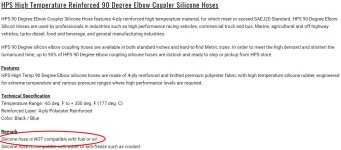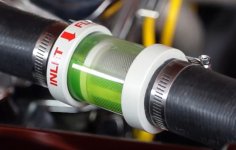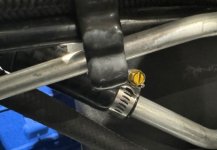FYI, today I looked at another 2005 GT with 43,000 miles. His power steering hoses to and from the reservoir were fine. I told him to keep an eye on them anyway.
Looking for power steering hose 05/06 GT
- Thread starter Vance
- Start date
You are using an out of date browser. It may not display this or other websites correctly.
You should upgrade or use an alternative browser.
You should upgrade or use an alternative browser.
Hey Pete, did you get a chance to look at the hose from underneath? Don't get me wrong, I too didn't appreciate "the sky is falling" rant on these hoses and I think that for whatever reason, there are still cars out there where they seem to be fine. However, when the DO start showing signs of porosity, it is most commonly the bottom side of the hose nearest the pump.FYI, today I looked at another 2005 GT with 43,000 miles. His power steering hoses to and from the reservoir were fine. I told him to keep an eye on them anyway.
Gotcha. We gotta add that feeling up technique to the PPI process! lolNope, just looked from the top and felt the hose as far as I could reach past the oil tank.
- Apr 19, 2016
- 206
Thanks Kendall. Just ordered one on your website. Will be installing at the next oil change.OK, so below you can see a couple of pictures of the replacement power steering line return hose. This is the hose that after almost 20 years exposed to power steering fluid, it is deteriorating from the inside out. Fortunately, the pressure line in our experience shows absolutely no signs of wear. This return line IS NOT rock science. This replacement hose can and should be routed the exact same way as the original line which means that there is no proximity to heat sources. You can see that our replacement hose is pretty much identical to the OEM hose which it replaces. We'd recommend doing this at your next oil change interval. Just remove the clamp at the pump and let the power steering fluid drain. After it is has drained, remove the clamp from the reservoir (up top on passenger side.) Then install this new line. You are welcome to use the OEM clamps but if you prefer a better hose clamp, we have included (2) stainless steel extended tail camps that will not bite into the hose. Frankly, as there is no pressure, not a lot of clamping force is needed.
Hose kit are available for shipping... we have a few on-hand but we can make more to keep up with demand.
Kits are $95 with the clamps and can be ordered HERE.
Below is a picture of the replacement hose followed by a picture of the replacement hose with an OEM hose so you can see that it is a near-exact replacement.
Yes and yes. It's a BMW part number hose (I think the details are earlier in this thread) and it just needs a ~7" extension. <insert joke here> We do that with a brass barb and two clamps. Remember, it's just a return hose!Just a question regarding the replacement hose. Is it one piece or is it two pieces joined together. It looks much like the hose on a previous BMW I had.
What power steering fluid is everyone using?
Or some are using a Royal Purple one (can’t recall the specifics)
I am sorry to say that I don't believe the hard line solution referenced in this thread is viable and we wouldn't recommend or install it because of two design challenges - the first of which is critical. Assuming the pictures on the website are an accurate representation of the product being sold, the soft hose that is being used is NOT compatible with petroleum-based products. Generally speaking, most silicone hoses in the market are not intended to be used with petroleum products (like power steering fluid) and that's why, for example, you don't see them used by the OEMS. But specifically, the hose shown on the website is made by HPS and this manufacturer specifically calls out this limitation. Here's a snapshot from their product page on their website.

Hopefully not too many of these kits have been manufactured/shipped but owners should be cautioned not to install the kit until/unless a remedy has been made available. This leads to the second, albeit less serious design challenge.
When looking at commonly available aluminum tubing it is relatively easy to source a tubing with an OD of 5/8" (.625). Similarly, power steering rated hose is commonly available in a 5/8" (.625) ID. Herein lies the problem when trying to connect these components. Engineering standards will typically call for a .025" - .035" size differential so that a good seal can be obtained without causing over-clamping distortion. The picture below illustrates such a fitment where the hose has virtually no distortion despite a vey snug clamp. The hose remains very uniform and not distorted/stressed.

In the case where you have the ID of the hose equal to the OD of the hard line (each at .625"), then you have a loose slip fit. In this scenario, a seal can only be achieved by an over-tightened clamp. The distortion on the hose is very obvious and presents a potential failure point. This was very evident in the case of what I assume to be one of the Beta cars utilizing this solution.

I know a superior clamping solution is being utilized in the updated kits (kudos to Rich for fast action on this), but as a long-term-intended solution a barbed or flared hard line end or a smaller ID soft hose would be an ideal resolution.
In the near term, I would recommend that owners look at post #5 in this thread. You can easily source the components for < $40 and then when/if a better solution does come along, you can easily swap over.

Hopefully not too many of these kits have been manufactured/shipped but owners should be cautioned not to install the kit until/unless a remedy has been made available. This leads to the second, albeit less serious design challenge.
When looking at commonly available aluminum tubing it is relatively easy to source a tubing with an OD of 5/8" (.625). Similarly, power steering rated hose is commonly available in a 5/8" (.625) ID. Herein lies the problem when trying to connect these components. Engineering standards will typically call for a .025" - .035" size differential so that a good seal can be obtained without causing over-clamping distortion. The picture below illustrates such a fitment where the hose has virtually no distortion despite a vey snug clamp. The hose remains very uniform and not distorted/stressed.

In the case where you have the ID of the hose equal to the OD of the hard line (each at .625"), then you have a loose slip fit. In this scenario, a seal can only be achieved by an over-tightened clamp. The distortion on the hose is very obvious and presents a potential failure point. This was very evident in the case of what I assume to be one of the Beta cars utilizing this solution.

I know a superior clamping solution is being utilized in the updated kits (kudos to Rich for fast action on this), but as a long-term-intended solution a barbed or flared hard line end or a smaller ID soft hose would be an ideal resolution.
In the near term, I would recommend that owners look at post #5 in this thread. You can easily source the components for < $40 and then when/if a better solution does come along, you can easily swap over.
Last edited:
HighHP
GT Owner
When looking at commonly available aluminum tubing it is relatively easy to source a tubing with an OD of 5/8" (.625). Similarly, power steering rated hose is commonly available in a 5/8" (.625) ID. Herein lies the problem when trying to connect these components. Engineering standards will typically call for a .025" - .035" size differential so that a good seal can be obtained without causing over-clamping distortion. The picture below illustrates such a fitment where the hose has virtually no distortion despite a vey snug clamp. The hose remains very uniform and not distorted/stressed.
In the case where you have the ID of the hose equal to the OD of the hard line (each at .625"), then you have a loose slip fit. In this scenario, a seal can only be achieved by an over-tightened clamp. The distortion on the hose is very obvious and presents a potential failure point. This was very evident in the case of what I assume to be one of the Beta cars utilizing this solution.
In the near term, I would recommend that owners look at post #4 in this thread. You can easily source the components for < $40 and then when/if a better solution does come along, you can easily swap over.
I did not know OEM called for a 0.030 tight fit. I have always noticed that OEM hose to fitting is tight. This allows spring clamps to work well. Using a 5/8 hose on a 5/8 fitting, spring clamps would always leak, and screw clamps would bunch up. Just as you mentioned above. Good to know.
Did you mean to look at post #5 above instead of post #4? Or just buy your hose set up?
QuickSilverShelby
GT Owner
Man, if a power steering hose is this difficult to sort out, how are we ever going to get replacement headlights?
QSS
QSS
Yes, I meant to reference Post #5. (I corrected it.) I couldn't care less if owners choose to buy our solution or not. Like I said originally, we have been installing them on cars for a few months now and it is just a damn return line... far from rocket science. I had (erroneously) thought that folks had implemented their own solution after the previous fiasco and there was no need for a "product". I think people can follow what was recommended in Post #5 but if they would prefer to have a pre-assembled version, sure, they can source it from us. I think the emphasis should be in having a solution available for the community rather than try to exploit owners. Enough said.Did you mean to look at post #5 above instead of post #4? Or just buy your hose set up?
Last edited:
Tomcat
GT Owner
So, is the power steering fluid we use (Ford XT-5-QMC MERCON-V) considered: "...fuel or oil" based?
Mercon V is 'fully synthetic' but don't know if that still means it's an 'oil'?So, is the power steering fluid we use (Ford XT-5-QMC MERCON-V) considered: "...fuel or oil" based?
Would like to hear from Rich regarding the black tubing ends of his hardline solution. I just received mine yesterday but am now hesitant to install it if the connections are just going to start weeping in a few months.
HighHP
GT Owner
Mercon V is 'fully synthetic' but don't know if that still means it's an 'oil'?
Would like to hear from Rich regarding the black tubing ends of his hardline solution. I just received mine yesterday but am now hesitant to install it if the connections are just going to start weeping in a few months.
Yes, it is a petroleum (fuel and oil) based product. Synthetic has become a loosely used and undefined term that is used by manufacturers for marketing. True synthetics were used and I believe developed for use in the aircraft industry in turbine engines. Very high temperature use and excellent lubrication qualities. True synthetics are very expensive and are very harsh requiring protection so it does not get on your skin.
Tomcat
GT Owner
So is the consensus we "should" replace the couplers at each end of the tube with ones that are more compatible with this application (and also get the smaller ID) per Kendall/Ryan CoolTech?Yes, it is a petroleum (fuel and oil) based product. Synthetic has become a loosely used and undefined term that is used by manufacturers for marketing. True synthetics were used and I believe developed for use in the aircraft industry in turbine engines. Very high temperature use and excellent lubrication qualities. True synthetics are very expensive and are very harsh requiring protection so it does not get on your skin.
Anyone done their due diligence and come up with a solution?
Tomcat: It ain't hard. Go to your auto parts store and get some hose rated for oil or hydraulic oil or power steering fluid (that's just hydraulic oil under a different name) that is the same diameter as the pipe and nipples. Replace the silicone hose with it. Done.
It doesn't matter whether the power steering fluid is mineral oil based or synthetic oil based. Chemically, they have the same effects on rubber hoses.
It doesn't matter whether the power steering fluid is mineral oil based or synthetic oil based. Chemically, they have the same effects on rubber hoses.
Last edited:
twobjshelbys
GT Owner
Or go down to your local heavy equipment dealer/service center, ie, case, etc. They make hoses with fittings on site but note they will not be "shaped'Tomcat: It ain't hard. Go to your auto parts store and get some hose rated for oil or hydraulic oil or power steering fluid (that's just hydraulic oil under a different name) that is the same diameter as the pipe and nipples. Replace the silicone hose with it. Done.
It doesn't matter whether the power steering fluid is mineral oil based or synthetic oil based. Chemically, they have the same effects on rubber hoses.

